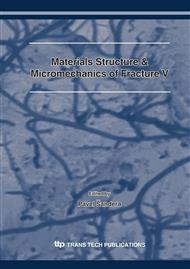p.321
p.325
p.329
p.333
p.337
p.341
p.345
p.349
p.353
The Optimization of the Isothermal Transformation Dwell of the ADI Obtained at Transformation Temperature of 380 °C
Abstract:
The structure of austempered ductile iron (ADI) matrix and consequently its mechanical properties are influenced by the heat treatment conditions, above all by the temperature and dwell length of isothermal transformation. The paper is focused on deeper understanding the interrelation between matrix mixture composition and static mechanical properties of ADI in dependence on the isothermal transformation dwell. Practical aim of the paper is to find the optimal isothermal transformation dwell range for ADI isothermally transformed at the temperature of 380 °C with emphasis on the level of static mechanical properties in tension. Microstructure and mechanical properties changes that proceed during isothermal transformation are observed and evaluated for the transformation dwells of 2, 5, 10, 25, 60, 120, 270, and 540 minutes.
Info:
Periodical:
Pages:
337-340
Citation:
Online since:
December 2007
Authors:
Price:
Сopyright:
© 2008 Trans Tech Publications Ltd. All Rights Reserved
Share:
Citation:


